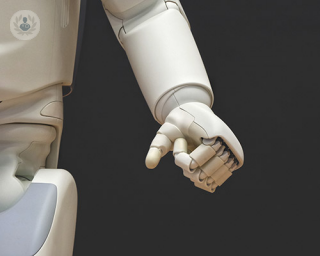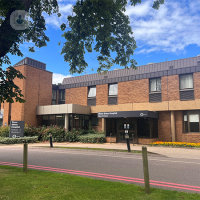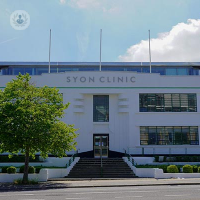Fibroids
Mr Christian Barnick - Obstetrics & gynaecology
Created on: 05-08-2017
Updated on: 05-09-2023
Edited by: Conor Dunworth
What are fibroids?
Fibroids are benign (non-cancerous) growths found anywhere in and around the uterus, which are made up of muscle and fibrous tissue. They are also known as uterine fibroids or myomas. Although only one uterine fibroid may develop, in most cases there will be several. These can vary in size from one millimetre to big masses that may expand and distort the uterus. In extreme cases, multiple fibroids can enlarge the uterus to the point that it reaches the rib cage, adding weight. Fibroids aren't dangerous but they can cause symptoms which may affect the quality of life.

There are different types of fibroid, including:
- Intramural fibroids: located in the muscle wall of the uterus, they are the most common type.
- Submucosal fibroids: located in the muscle layer found beneath the uterine lining, developing into the womb cavity.
- Subserosal fibroids: located outside the wall of the uterus, developing into the pelvis. This type can be quite large and can be a reason for infertility and miscarriage.
- Pedunculated fibroids: these are subserosal or submucosal fibroids that are attached to the uterus by a narrow stem of tissue.
What are the symptoms of fibroids?
In general, women with fibroids will not have any symptoms. However, some women will experience symptoms, including:
- Heavy and/or painful periods
- Long periods, lasting more than a week
- Lower back pain
- Abdominal pain
- Pressure and pain in the pelvis
- Constipation
- Pain during sex
- Increased need to urinate
These symptoms may be affected by the size, location and number of fibroids.
What causes uterine fibroids?
The exact cause of uterine fibroids is unknown, but it is believed that they may be caused by the hormone oestrogen. Oestrogen is the female reproductive hormone produced by the ovaries and when oestrogen is at its highest during the reproductive years, fibroids may develop. Fibroids will often shrink when oestrogen levels are low, such as after menopause.
Fibroids are fairly common, with one in three women having them at some point during their life. Fibroids are thought to be more common in women of African-Caribbean origin, as well as in obese or overweight women.
Women who have had children are less likely to have fibroids.
How are fibroids diagnosed?
Given that symptoms are uncommon, fibroids are usually detected during a routine gynaecological examination, a pelvic exam or a prenatal ultrasound.
If there is suspicion of fibroids, your doctor might order an ultrasound to confirm the diagnosis of fibroids and determine their size and location.
Can fibroids be prevented?
Uterine fibroids cannot be prevented.
How are fibroids treated?
The type of treatment will depend on several factors, including the patient's age, general health, symptoms, type of fibroids and if she wants to have children in the future.
If fibroids are not causing symptoms, then treatment will not be required. Over time and in most cases, these fibroids will shrink and disappear. This is usually the case with small fibroids.
If fibroids are asymptomatic, medication will usually be recommended first to alleviate symptoms and even help to shrink fibroids. These can range from oral contraceptives which help control heavy menstrual periods to nonsteroidal anti-inflammatory drugs for colics or pain.
In severe cases or if medication is ineffective, treatment requires removal of the fibroid, which is done with surgery. Fibroids don't need to be a certain size in order for them to be removed.
The most common surgery options are:
- Uterine artery embolization (UAE): the blood supply to the fibroids is blocked, causing them to shrink.
- Endometrial ablation: lasers or heat are used to remove the womb lining (endometrium), and it can be used to remove smaller fibroids, however, the option of pregnancy after this can be affected.
- Myomectomy: fibroids are removed from the uterus, but the uterus is left in place. Fibroids can return after this procedure, which is usually recommended for women with subserosal and intramural fibroids.
- Hysterectomy: the definitive procedure, in which the uterus is removed. Fibroids will not return after this procedure, but you will no longer be able to become pregnant.
Each type can have an affect on the ability to have children afterwards, so this will need to be a discussion with your doctor.
Fibroids and pregnancy
In some cases, fibroids can cause issues during pregnancy and deilvery, including miscarriage, placental abruption, preterm delivery and a breech birth. Women who have fibroids are also six times more likely to need a C-section.

Are fibroids cancerous?
Fibroids are almost always non-cancerous and having fibroids will not increase your risk of developing uterine cancer or other types of cancer. Only in extremely rare cases (less than one in 1,000) will fibroids develop into cancer, called a leiomyosarcoma.
Are fibroids hereditary?
Many fibroids contain gene mutations that make them different from those found in healthy muscle cells of the uterus. This suggests that you may be at increased risk of developing fibroids if your mother or sister also have (or had) them.
Can fibroids burst and bleed?
In rare occasions, fibroids may burst due to an increase in blood or abdominal pressure, a twisted fibroid, an injury or a cut in blood supply to the fibroid. A ruptured fibroid may lead to serious complications such as acute blood loss.
If you experience severe abdominal pain, seek medical attention immediately as this might mean that a fibroid has burst.
Are fibroids the same as polyps?
While both can look very similar in imaging tests and cause the same symptoms, polyps are made of endometrial tissue found in the uterus lining. Unlike fibroids, polyps may grow to block the opening of the fallopian tubes, which affects fertility. There is a higher risk for cancer, too - almost five per cent of polyps can turn out to be cancerous.

















